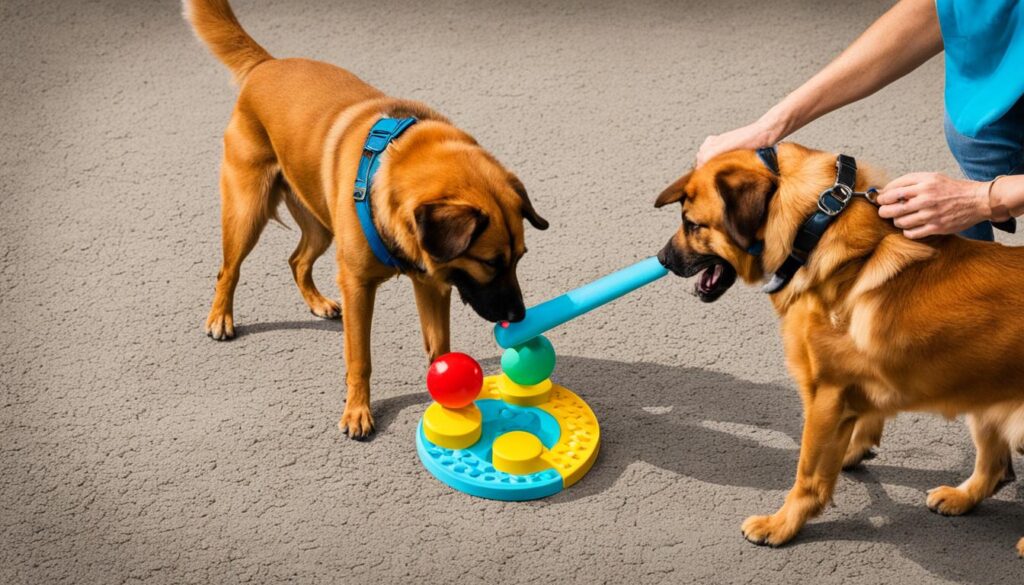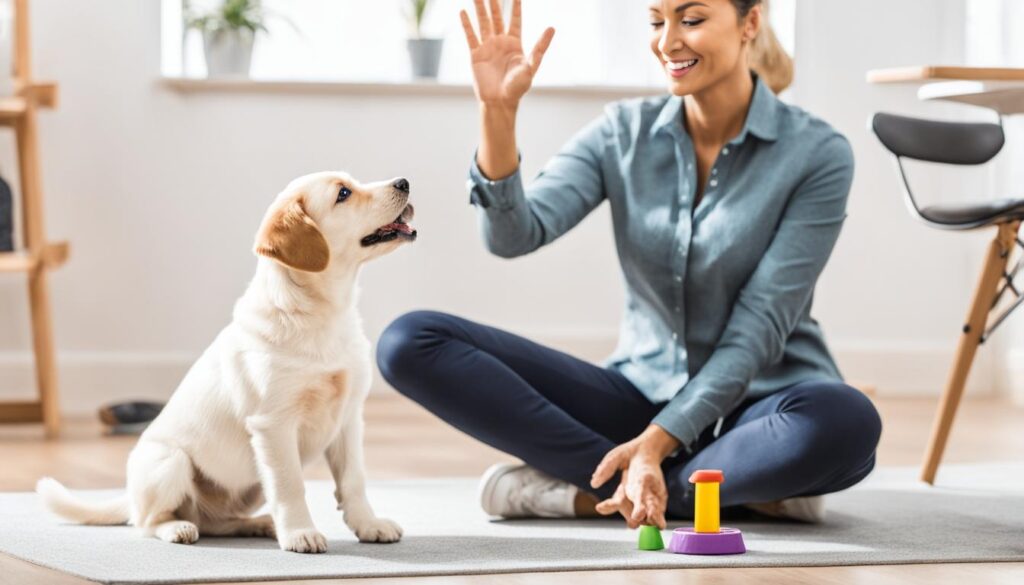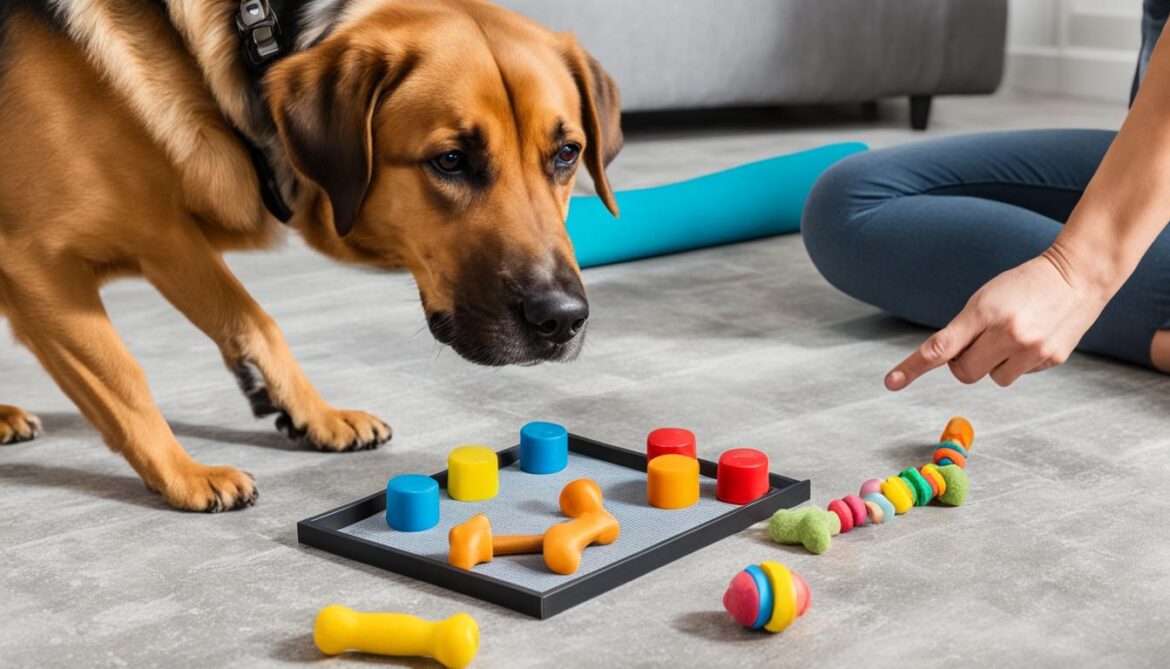Are you looking for effective dog training tips to improve your furry friend’s behavior? Dog behavior training basics are crucial for developing obedience and a harmonious bond between you and your dog. In this section, we will cover foundational aspects of dog behavior training and provide valuable tips and techniques to effectively train your dog at home.
Obedience training for dogs is the key to a happy and healthy relationship between you and your furry friend. By equipping yourself with basic dog training techniques, you can shape your dog’s behavior and strengthen their obedience. Consistency and patience are essential throughout the training process, and positive reinforcement is a proven method to establish a strong bond with your dog.
Dog Behavior Training Basics: Key Takeaways
- Developing obedience in dogs is essential for a healthy relationship between you and your furry friend.
- Consistency and patience are key in the training process.
- Positive reinforcement is a proven method to establish a strong bond with your dog.
- Mastering dog behavior training basics can lead to a happier and more harmonious home.
Understanding Dog Behavior and Modification Techniques
Training your furry friend requires a clear understanding of their behavior, as it’s crucial for effective training. Positive reinforcement training methods are effective behavior modification techniques that enable you to establish a strong and lasting bond with your dog. In this section, we’ve compiled a few tips to help guide you in identifying and correcting problem behaviors in your dog using positive reinforcement techniques.
Identify Problem Behaviors
The first step of behavior modification is identifying problematic behaviors. Common behavior problems in dogs include aggression, separation anxiety, and inappropriate chewing, digging, or marking. Understanding the underlying causes of these behaviors is essential in developing a behavior modification plan that works.
Positive Reinforcement Training
The positive reinforcement training method is a friendly and effective way to train your dog without resorting to physical punishment. By rewarding good behavior with treats, praise, or affection, you’re not only teaching your dog to behave well, but strengthening your bond with them. Positive reinforcement techniques work best when used consistently.
| Examples of Positive Reinforcement Training Techniques | When to Use Them |
|---|---|
| Clicker Training | To reinforce specific behaviors like sit, stay or come. |
| Target Training | To improve your dog’s focus and attention. |
| Marker Training | To improve communication between you and your dog. |
Problem-Solving Dog Behavior
Problems with your dog’s behavior can be challenging, but there are solutions. For example, if your dog is displaying aggressive behavior, it’s important to identify the root cause and address it with a consistent behavior modification plan that reinforces positive behavior. If your dog is experiencing separation anxiety, consider providing them with a cozy crate, playing music, or leaving a piece of your clothing with them to feel more secure.
Remember, training your dog is a continuous process. Don’t be discouraged if it takes time for your furry friend to learn new habits. Consistency and patience are key in achieving long-term success.

Puppy Training Basics and Establishing Basic Commands
So, you’ve adopted a new puppy? Congratulations! Proper training is key to establishing good behavior and obedience for your pup. To get started, here are a few puppy training basics:
- Start training early and be consistent. Puppies are like sponges and can quickly pick up on habits that they see others doing.
- Focus on positive reinforcement. Reward your puppy for exhibiting good behavior, instead of punishing them for bad behavior.
- Establish a routine for eating, sleeping, and training. This will help your pup establish good habits and reduce anxiety.
Basic Dog Commands
Teaching your puppy basic commands is essential for building a foundation of obedience. Here are a few basic dog commands to get started:
| Command | Description |
|---|---|
| Sit | Teach your puppy to sit on command by holding a treat above their head. When they sit, reward them with the treat and a positive affirmation like “good sit.” |
| Stay | After your puppy has mastered the sit command, practice the stay command by stepping back a few feet with your hand up and saying “stay.” Reward them for staying and gradually increase the distance you step back. |
| Come | Call your puppy’s name and say “come.” When they come to you, reward them with a treat and positive affirmation like “good come.” |
| Heel | Train your puppy to walk by your side on a leash by saying “heel” and rewarding them for staying by your side. |
Puppy Training Tips
Training a young puppy can be challenging, but with the right approach and patience, you can set them up for success. Here are a few puppy training tips to keep in mind:
- Keep training sessions short and frequent, around 5-10 minutes, to maintain your puppy’s focus and attention.
- Use high-value treats as rewards for good behavior, such as small pieces of cooked chicken or cheese.
- Make sure your puppy gets enough exercise, playtime, and socialization to prevent behavioral problems.
By implementing these puppy training basics and establishing fundamental commands, you’ll help your puppy develop into a well-behaved, obedient dog. Remember to be patient and consistent, and celebrate their successes along the way.

Effective Dog Training Methods and Exercises
Training your dog can seem like a daunting task, but with the right techniques and exercises, it can be a fun and rewarding experience for both you and your furry friend. In this section, we’ll explore various dog training techniques and exercises that have been proven to be effective in shaping a dog’s behavior and improving their obedience.
Basic Dog Training Techniques
Before diving into specific exercises, it is essential to understand the foundational basic dog training techniques to ensure a smooth training process. One of the most important techniques is positive reinforcement, which involves rewarding good behavior with treats, praise, or playtime. Consistency is also vital, as dogs respond well to a routine and clear expectations. Additionally, setting realistic goals and being patient is key to a successful training outcome.
Dog Training Exercises
Now that you understand the basics, it’s time to explore dog training exercises that are fun and effective for both you and your dog. One popular exercise is the “Sit-Stay” command, which involves having your dog sit and remain in place until released. Another effective exercise is “Come When Called,” which entails teaching your dog to come when called, even in challenging distractions.
| Exercise | Description |
|---|---|
| Sit-Stay | Teaches your dog to sit and stay in place until released |
| Come When Called | Teaches your dog to come when called, even in challenging distractions |
| Heel | Teaches your dog to walk beside you calmly and without pulling on the leash |
| Down-Stay | Teaches your dog to lie down and stay in place until released |
It’s important to note that training a dog’s behavior requires more than just these exercises. Consistency, positive reinforcement, and a clear understanding between you and your dog are key to a successful training process.
Advanced Dog Training Techniques
For those looking to take their dog training to the next level, there are several advanced dog training techniques that can be used. One popular method is clicker training, which uses a clicker and treats to reinforce desired behaviors. Another technique is shaping, which involves breaking a behavior down into small steps to gradually build up to the desired outcome.
Remember, training a dog’s behavior takes time and patience. But with the right techniques and exercises, you can build a strong bond with your furry companion and enjoy a happy, well-behaved dog.
Conclusion
Congratulations on making it through this comprehensive guide to some dog behavior training basics! By taking the time to understand your dog’s behavior and using positive reinforcement techniques, you can enjoy a well-behaved and happy furry friend.
Remember to be patient and consistent with your training efforts, and always focus on strengthening your bond with your dog. Whether you are teaching basic commands to a new puppy or modifying problematic behavior in an older dog, the tips and techniques covered in this article can help you achieve success.
Thank you for reading and good luck with your dog training journey!
FAQ
What are some basic dog training basics tips for beginners?
When starting with dog training, it’s important to be patient and consistent. Use positive reinforcement techniques, such as treats and praise, to reward desired behavior. Set clear expectations and boundaries, and focus on one command at a time. Remember, training takes time and effort, so be prepared for some trial and error along the way.
How can I effectively train my dog to obey basic commands?
To train your dog to obey basic commands, start with simple commands like sit, stay, and come. Use treats or rewards to motivate your dog and make it a positive experience. Break down the commands into small steps and gradually increase difficulty. Consistency is key, so reinforce the commands daily, and practice in different environments to generalize the behavior.
What is positive reinforcement training and why is it effective?
Positive reinforcement training is a method that rewards desired behavior rather than punishing unwanted behavior. It involves using treats, praise, or other rewards to reinforce good behavior, making the dog more likely to repeat it. Positive reinforcement creates a positive association with training, builds trust, and strengthens the bond between you and your dog.
How can I address common behavior problems in my dog?
Common behavior problems in dogs can be addressed through a combination of understanding the root cause, consistency, and positive reinforcement techniques. Identify the triggers for the behavior problem and modify the environment or circumstances accordingly. Seek professional help if necessary to develop a behavior modification plan tailored to your dog’s specific needs.
What is the best way to leash train my dog?
Leash training requires patience and consistency. Start by getting your dog comfortable with wearing a leash and collar. Use positive reinforcement to reward your dog for walking calmly on the leash. Start with short walks and gradually increase the duration and distance. Avoid pulling on the leash and encourage your dog to walk by your side. Practice leash training in different environments to reinforce the behavior.
How can I house train my dog effectively?
House training your dog involves establishing a routine and consistent reinforcement of desired behaviors. Take your dog outside at regular intervals, especially after meals and naps, and reward them when they eliminate in the appropriate spot. Supervise your dog indoors to prevent accidents and use verbal cues or commands to indicate where they should eliminate. Be patient and consistent, and avoid punishment for accidents.
What are some basic dog training commands I should teach my dog?
Some dog behavior training basics commands you should teach your dog include sit, stay, come, lie down, and leave it. These commands provide the foundation for good behavior and obedience. Start with one command at a time, using positive reinforcement to reward your dog’s compliance. With consistent training, your dog will become proficient in these commands and will be easier to manage in different situations.
What are some effective dog training exercises to improve behavior?
Effective dog training exercises to improve behavior include focus and attention exercises, impulse control exercises, and socialization exercises. Focus and attention exercises help your dog learn to pay attention to you and follow commands. Impulse control exercises teach your dog to wait for cues and control impulses, promoting better behavior. Socialization exercises expose your dog to different environments, people, and other animals to build confidence and reduce fear or aggression.
NOTE: If you purchase a product through links on this page, we receive a small commission at no cost to you. We were not paid for writing the contents in this page. We are suggesting the dating and relationship products in this page because we believe that it would address your dating and relationship issues, problems and needs. For more information, please see our disclosure policy.
